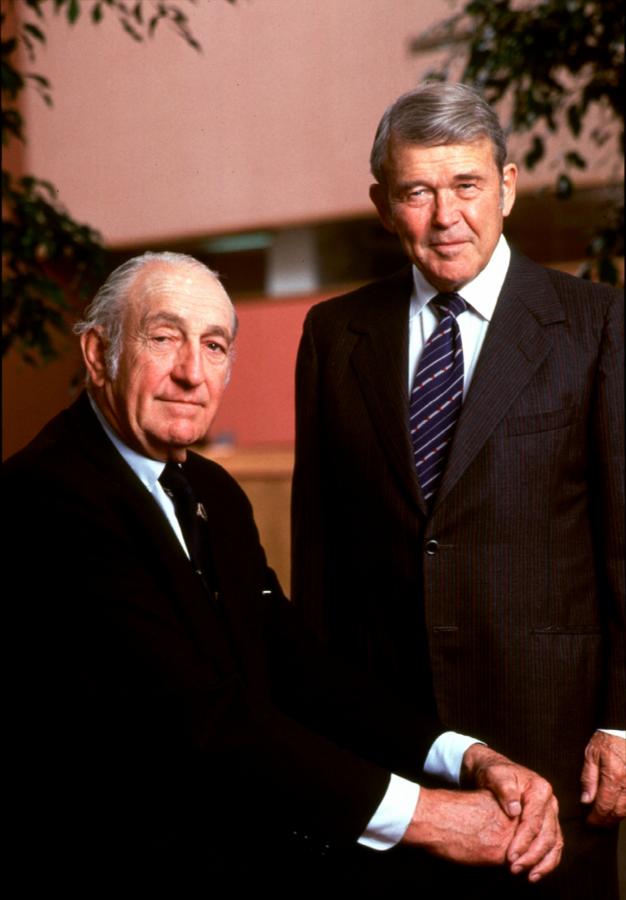What was David Packard's net worth?
David Packard was an American electrical engineer, entrepreneur and philanthropist who had a net worth of $4 billion at the time of his death in 1996. That's the same as having around $6.6 billion in today's dollars. He was best known for being the co-founder of Hewlett-Packard. He also served as the 13th United States Deputy Secretary of Defense under President Richard Nixon from January 1969 to December 1971.
Packard's journey took him from a small-town boy in Pueblo, Colorado, to a pioneer in the global technology industry. His contributions extended far beyond the sphere of business, reaching into realms of public service, environmental conservation, and philanthropy. His legacy, encompassing the famed HP Way management philosophy and the David and Lucile Packard Foundation, continues to influence modern corporate culture and philanthropic endeavors.
Packard received the Presidential Medal of Freedom in 1988. He also received the Sylvanus Thayer Award and the Public Welfare Medal. David Packard passed away on March 26, 1996 at 83 years old.
Wealth and Philanthropy
David was philanthropic almost from the moment he became wealthy but truly began to dedicate himself to philanthropy in the early 1980s. In 1986 they donated $40 million to establish the Lucile Packard Children's Hospital at Stanford University. The newly-built hospital opened in 1991. At the urging of his daughters, they donated the funds needed to create the Monterey Bay Aquarium Foundation, eventually committing $55 million to build the aquarium which opened in 1984.
In 1994, David and his co-founder Bill Hewlett donated $77 million to establish the David Packard Electrical Engineering Building at Stanford University.
In 1964 he and wife Lucile established the David and Lucille Packard Foundation. At the time of his death, David donated the bulk of his $4 billion estate to the foundation. Today the foundation's assets are worth more than $8 billion. It is one of the 20-largest foundations in the US.
Bill Hewlett was no slouch himself, when it came to philanthropy. In 1966, two years after David founded his foundation, Bill founded The William and Flora Hewlett Foundation. When Flora Hewlett died in 1977 she earmarked a huge grant of equity and funds for the foundation. By the time the funds were delivered in 1981, the foundation received $300 million from Flora's estate. That's the same as $850 million today. With continued contributions and stock appreciation, by the mid-1990s the foundation controlled $800 million. When Bill died in 2001, he was worth $9 billion. He left approximately $8.5 million of his assets to the foundation. Today The William and Flora Hewlett Foundation controls $10 billion in assets.

David Packard and Bill Hewlett (Photo courtesy of Hewlett-Packard/Newsmakers)
Early Life and Education
Born to Sperry and Ella Packard, David developed a fascination for technology and engineering early in life, often tinkering with radios and appliances. After high school, he pursued his passion at Stanford University, where he earned a degree in electrical engineering in 1934. At Stanford, he also met Bill Hewlett, starting a friendship that would eventually turn into one of the most successful business partnerships in history.
Formation of Hewlett-Packard
After graduating, Packard worked for the General Electric Company in New York. However, the allure of the West Coast and the dream of starting an enterprise with Hewlett led him back to California. With a coin toss deciding the order of their names, Hewlett-Packard was born in 1939 in a small garage in Palo Alto – now widely considered the birthplace of Silicon Valley. Their first product was an audio oscillator, the HP200A, a highly successful instrument used in sound engineering.
The HP Way and Business Success
Under Packard's leadership, HP grew rapidly, diversifying into various tech products, including calculators, computers, and printers. However, Packard's influence was not merely in business success; it was in creating an innovative and employee-focused corporate culture known as the HP Way. This management philosophy emphasized respect for employees, frugality, and social responsibility. Packard's belief in 'management by walking around' promoted open communication and fostered a sense of community within the organization.
Public Service
Packard's contributions weren't limited to HP. From 1969-1971, he served as the U.S. Deputy Secretary of Defense under President Nixon. During his tenure, he applied his management philosophy to the Pentagon, implementing cost-saving measures and fostering a more efficient bureaucracy. His work in public service was a testament to his commitment to civic duty and his management expertise.
Philanthropy and Conservation Efforts
Packard's philanthropic efforts were as impressive as his business acumen. In 1964, he and his wife, Lucile, established the David and Lucile Packard Foundation. The foundation, one of the wealthiest in the U.S., supports numerous causes, including environmental conservation, science, children's health, and the arts. Packard also played a crucial role in the creation of the Monterey Bay Aquarium, further demonstrating his commitment to environmental conservation.
Later Life and Legacy
Packard stepped down from HP's board in 1993 but remained an influential figure in the company and the tech industry. When he passed away in 1996, he left behind a legacy of innovation, strong corporate culture, and philanthropy. His vision and values continue to guide HP and influence Silicon Valley's ethos.
/2020/08/dp.jpg)
/2010/10/Mark-Hurd-e1738013640156.jpg)
/2010/08/GettyImages-483025784.jpg)
/2010/08/jode.jpg)
/2010/09/Gordon-Moore-1.jpg)
/2020/08/bh2.jpg)
/2022/10/Rod-Blagojevich.jpg)
/2013/02/Curt-Schilling.jpg)
/2012/05/GettyImages-499219150.jpg)
/2010/12/Brooke-Hogan-1.jpg)
/2012/10/Nick-Hogan.jpg)
/2019/09/chuck-lorre-1.jpg)
/2016/11/GettyImages-93351549.jpg)
/2022/06/paul-.jpg)
/2010/12/randy.jpg)
/2019/09/seth-macfarlane.jpg)
/2020/03/deion-sanders.jpg)
/2020/08/dp.jpg)
/2020/08/bh2.jpg)
/2020/08/pacl2.jpg)
/2014/07/thumb-1.jpg)
/2010/07/GettyImages-180366336.jpg)
/2012/12/wk-2.png)
/2010/09/Gordon-Moore-1.jpg)
/2018/10/Jensen-Huang.jpg)